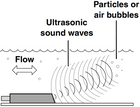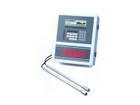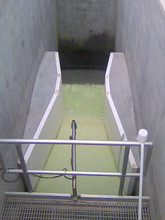 Loading... Please wait...
Loading... Please wait...Categories
New Products
NEWSLETTER
To Ponder
Product Description
TRACOM offers seven type of flumes for open channel flow monitoring: Parshall, Palmer-Bowlus, H-Type, Trapezoidal, Cutthroat, RBC, and Montana. Each flume has its own advantages and disadvantages and it is recommended that before selecting a flume that the characteristics of each flume be considered. Please share your specific application with us so we can make a proper recommendation and quotation.
Level vs Flow comparison tables
Parshall / Palmer-Bowlus Flume Typical Discharge Capacities
Trapazoidal / HS / H/ HL / RBC Flume Typical Discharge Capacities
Weir & Flume Discharge Equations
Following are some highlights of the various flume choices:
Parshall
- Most widely used type of flume for permanent installations
- Standard design conforms to U.S. Department of the Interior, Bureau of Reclamation, Water Measurement Manual
- Available in throat widths of 1” to 180”
- Resistant to the effects of submergence
- 50% for 1” - 3” flumes
- 60% for 6” and 9” flumes
- 70% for 12” - 96” flumes
- 80% for 120” - 600” flumes
- Self-cleaning in most circumstances (not recommend for sanitary use in 1” and 2” sizes)
- Available in nested configurations
- Available with end adapters to connect to existing pipe
- Simple flow meter calibration
- Maximum flow rates from 85.3 GPM – 467,200 GPM with standard wall heighths
- Installation requires drop in conduit invert from inlet to outlet
Palmer-Bowlus
- 4”-108” sizes available (sized by throat width)
- Three primary styles:
- 4D+1” (permanent style with integral approach section)
Point of measurement inside of the flume - 2D+1” (short sectioned flume with only the trapezoidal ramp)
Point of measurement upstream of the flume - Insert style (2D+1” length but no end flanges and O.D. of flume is I.D. of pipe)
Potential problems with accuracy due to reduced flume width
- 4D+1” (permanent style with integral approach section)
- Available with bulkheads to connect to existing pipe
- 4D+1” – inlet and outlet
- 2D+1” – outlet only
- Insert style – N/A
- No invert drop required
- Easily installed in manholes or round bottom channel
- Maximum flow rates from 55.2 GPM – 198,535 GPM
- Proprietary design varies from manufacturer to manufacturer
- Smaller useful range of flows
- Sedimentation at lower flow velocities
- Requires 25 straight run pipe diameters upstream
HS / H / HL-Type
- Standard design conforms to U.S. Department of Agriculture, Field Manual for Research in Agricultural Hydrology
- Available in a wide range of sizes from 0.4’ HS – 4.0’ HL
- Developed for agricultural runoff
- Approach section and inlet bulkhead available for connection to existing pipe
- Simple flow meter calibration
- Flat bottom for self-cleaning of small debris
- Wide range of flows
- Maximum flow rates from 36.0 GPM – 52,509.6 GPM
- Discharge must be unimpeded or spill freely from flume
- Cannot operate under submerged conditions
- Require 3-5 times the maximum head in straight channel upstream of the flume
Trapezoidal
- Initially designed to measure flows in irrigation channels
- Conforms to the normal shape of ditches (minimizing transition)
- Operates under higher degrees of submergence than Parshall flumes
- Straight through bottom permits the passage of debris
- Excellent usable head at low flow rates
- Maximum flow rates from 43.0 GPM – 663.8 GPM (Small to Extra Large 60 Degree V Trapezoidal)
- End adapters are available for Small, Large, and Extra Large 60 Degree V Trapezoidal flumes to connect to existing pipe
Cutthroat
- Similar to Parshall flumes except with flat bottom and no extended throat
- Developed for use in flat gradient channels
- Operates satisfactorily under both free and submerged flow conditions
- Sized by flume length and throat width
- Simpler construction than Parshall flumes
- Simple flow meter calibration
- Flat bottom for self-cleaning of small debris (1” and 2” throat widths not recommended for sanitary flows)
- Maximum flow rates from 52.6 GPM – 43,494 GPM
- Not available with standard end adapters to connect to existing pipe
- Most common uses include stream gauging and flow splitting
RBC
- Developed for use in small furrows and unlined canals
- Simple construction
- Scaled versions of the general flume
- Five throat widths (50mm, 75mm, 100mm, 150mm, 200mm)
- Ideal for very low flow rates
- Maximum flow rates from 22.98 GPM – 790.79 GPM
- Inlet and outlet wingwalls recommended for use in unlined canals
- Portable
- Caution should be used in flows with solids
Montana
- Design is a Parshall flume with the throat and discharge sections removed
- Uses the same discharge table as a similarly sized Parshall flume
- Standard design conforms to U.S. Department of the Interior, Bureau of Reclamation, Water Measurement Manual
- Available in throat widths of 1” to 180”
- Self-cleaning in most circumstances (not recommend for sanitary use in 1” and 2” sizes)
- Available in nested configurations
- Available with inlet end adapter to connect to existing pipe
- Simple flow meter calibration
- Maximum flow rates from 85.3 GPM – 467,200 GPM
- Cannot withstand any degree of submergence
- Not commonly used







